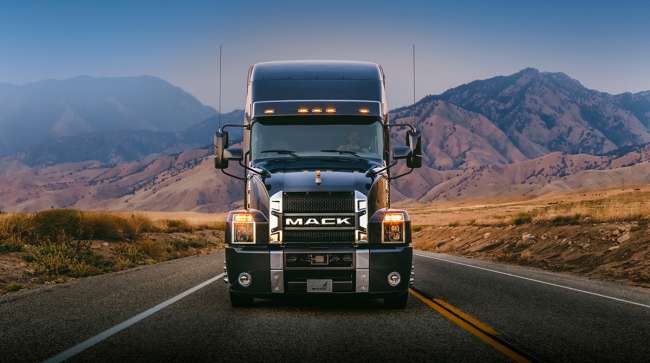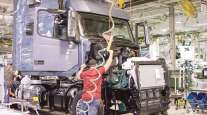Senior Reporter
December Class 8 Orders Fourth-Best Ever

[Stay on top of transportation news: Get TTNews in your inbox.]
North American Class 8 orders in December notched the fourth-highest volume ever as they surpassed 50,000 for the second consecutive month, according to ACT Research citing truck makers’ initial data.
Preliminary net orders in December reached 50,900 compared with 20,073 net orders a year earlier, ACT reported.
Full-year orders were 278,400 compared with 180,995 in the 2019 period. In 2018, Class 8 orders reached the all-time high of 490,100.
Preliminary NA Class 8 net orders in December were 50,900 units, down 2% from November, but a 153% improvement from year-ago December.https://t.co/cxlmGYEHqj#truck #semitruck #trucking #transportation pic.twitter.com/E6bt2rPq2q — ACT Research (@actresearch) January 7, 2021
Industry analysts reiterated the coronavirus pandemic, still sweeping through the country, is the catalyst for the high demand for goods-related freight demand. And the ongoing pandemic lent truck orders increasing momentum. Now, orders have surged — leaving far behind April’s tally of 4,251 that was the lowest Class 8 monthly volume since 1995.
“Fleets are looking at the freight environment in the coming year and are clearly willing to order more trucks,” ACT Vice President Steve Tam told Transport Topics.
Orders placed in the fourth quarter were the second-highest total in history, 142,093, and accounted for 51% of the 2020 total, and trailed only the third-quarter 2018 total of 148,439, according to ACT.
Robert Braswell, executive director of American Trucking Associations’ Technology & Maintenance Council, told Transport Topics the sudden burst in truck orders beginning with the “huge spike” in November [52,104 orders, and 39,089 in October] “will persist into 2021, and put pressure on parts for replacements.”
At the same time, ACT reported the preliminary net Classes 5-7 orders hit 31,500, the second-highest monthly volume ever. The highest was 41,315 in March 2006.
“That’s also going to increase competition for parts because, while the parts themselves may not be common,” Tam said, “many of the manufacturers are, so that will put pressure on the supply chain.”
@FTRintel Reports Preliminary North American Class 8 Net Orders for 2020 End on High Note with December Activity Remaining at Extremely High Level: https://t.co/BJcAqJwqcv#Trucking #Logistics #Class8 #Class8Orders #FTR #DonAke #NetOrders pic.twitter.com/IGXtZBFWMj — FTR | Transportation Intelligence (@FTRintel) January 7, 2021
FTR pegged December’s preliminary net order total at 52,100.
When you just look at trucking, said Don Ake, vice president of commercial vehicles, “the freight economy is booming, fleets are making lots of money, and they’re happy and confident. However, if you go outside the numbers, you still have the pandemic raging and still have factors in the employment market not moving as quickly as they could. So there are still some things out there to be concerned about.”
Meanwhile, truck orders seem to have stepped over the related issue of a driver shortage, as fleets begin to raise driver pay to boost retention.
Ake expects the delivery of vaccines to drivers on the sidelines will bring them back, especially older drivers with health conditions.
“They are going to be clamoring to get to the front of the line for one of these vaccines,” Ake said. “As soon as you are vaccinated, you can go back to work again.”
But that won’t happen like flipping a switch, he added. “But I think it is going to happen.”
One truck maker executive said agility was required amid the pandemic.

Koeck
“We must respond to our customers’ needs and adapt our business accordingly,” said Magnus Koeck, vice president of strategy at Volvo Trucks North America. “We are looking forward to a strong 2021 and feel very positive going into the new year.”
Another truck maker executive said consumer spending was strong in December, while manufacturing and construction spending were stable.
“Customer demand for Mack has shown strength across all Class 8 segments as a result of our fuel-efficient and reliable trucks, as well as our commitment to uptime support for our customers,” said Jonathan Randall, Mack Trucks senior vice president of North American sales.
VTNA and Mack are brands of the Volvo Group.
Meanwhile, regarding the medium-duty market, ACT President Kenny Vieth said, “There is a symbiotic relationship between heavy-duty freight rates and medium-duty demand. Clearly, the shift in consumer spending from experiences to goods has been good for the providers of local trucking services as e-commerce has grown by leaps and bounds during the pandemic.”
The U.S. Census Bureau reported, on a not adjusted basis, its estimate of U.S. retail e-commerce sales for the third quarter of 2020 totaled $199.4 billion. That was an increase of 37.1% compared with the third quarter of 2019 while total retail sales increased 6.9% in the same period.
Ake added it is still difficult to forecast the second half of the year “because the circumstances we are dealing with are so unique.”
Want more news? Listen to today's daily briefing:
Subscribe: Apple Podcasts | Spotify | Amazon Alexa | Google Assistant | More




